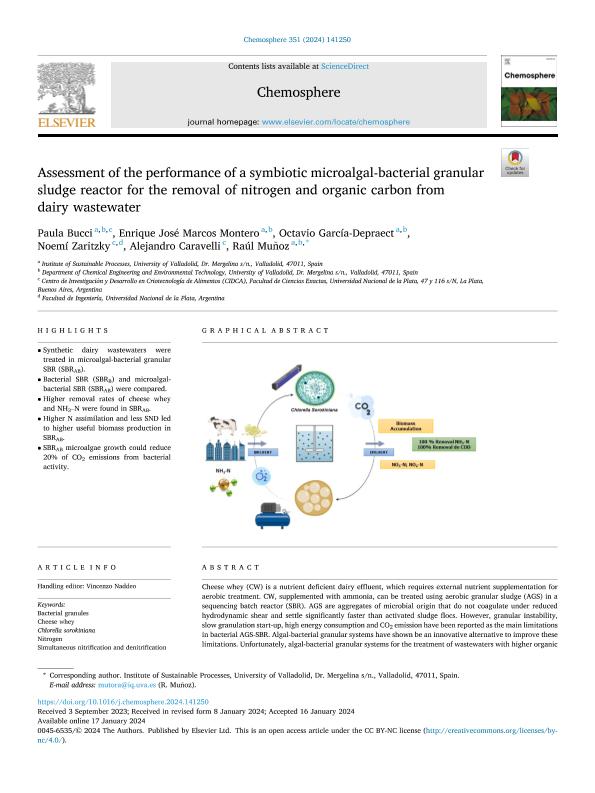Artículo
Assessment of the performance of a symbiotic microalgal-bacterial granular sludge reactor for the removal of nitrogen and organic carbon from dairy wastewater
Bucci, Paula Lorena ; Montero, Enrique José Marcos; García Depraect, Octavio; Zaritzky, Noemi Elisabet
; Montero, Enrique José Marcos; García Depraect, Octavio; Zaritzky, Noemi Elisabet ; Caravelli, Alejandro Horacio
; Caravelli, Alejandro Horacio ; Muñoz, Raúl
; Muñoz, Raúl
 ; Montero, Enrique José Marcos; García Depraect, Octavio; Zaritzky, Noemi Elisabet
; Montero, Enrique José Marcos; García Depraect, Octavio; Zaritzky, Noemi Elisabet ; Caravelli, Alejandro Horacio
; Caravelli, Alejandro Horacio ; Muñoz, Raúl
; Muñoz, Raúl
Fecha de publicación:
01/2024
Editorial:
Pergamon-Elsevier Science Ltd
Revista:
Chemosphere
ISSN:
0045-6535
Idioma:
Inglés
Tipo de recurso:
Artículo publicado
Clasificación temática:
Resumen
Cheese whey (CW) is a nutrient deficient dairy effluent, which requires external nutrient supplementation for aerobic treatment. CW, supplemented with ammonia, can be treated using aerobic granular sludge (AGS) in a sequencing batch reactor (SBR). AGS are aggregates of microbial origin that do not coagulate under reduced hydrodynamic shear and settle significantly faster than activated sludge flocs. However, granular instability, slow granulation start-up, high energy consumption and CO2 emission have been reported as the main limitations in bacterial AGS-SBR. Algal-bacterial granular systems have shown be an innovative alternative to improve these limitations. Unfortunately, algal-bacterial granular systems for the treatment of wastewaters with higher organic loads such as CW have been poorly studied. In this study, an algal-bacterial granular system implemented in a SBR (SBRAB) for the aerobic treatment of ammonia-supplemented CW wastewaters was investigated and compared with a bacterial granular reactor (SBRB). Mass balances were used to estimate carbon and nitrogen (N) assimilation, nitrification and denitrification in both set-ups. SBRB exhibited COD and ammonia removal of 100% and 94% respectively, high nitrification (89%) and simultaneous nitrification-denitrification (SND) of 23% leading to an inorganic N removal of 30%. The efficient algal–bacterial symbiosis in granular systems completelyremoved COD and ammonia (100%) present in the dairy wastewater. SBRAB microalgae growth could reduceabout 20% of the CO2 emissions produced by bacterial oxidation of organic compounds according to estimatesbased on synthesis reactions of bacterial and algal biomass, in which the amount of assimilated N determined bymass balance was taken into account. A lower nitrification (75%) and minor loss of N by denitrifying activity(<5% Ng, SND 2%) was also encountered in SBRAB as a result of its higher biomass production, which could beused for the generation of value-added products such as biofertilizers and biostimulants.
Archivos asociados
Licencia
Identificadores
Colecciones
Articulos(CIDCA)
Articulos de CENTRO DE INV EN CRIOTECNOLOGIA DE ALIMENTOS (I)
Articulos de CENTRO DE INV EN CRIOTECNOLOGIA DE ALIMENTOS (I)
Citación
Bucci, Paula Lorena; Montero, Enrique José Marcos; García Depraect, Octavio; Zaritzky, Noemi Elisabet; Caravelli, Alejandro Horacio; et al.; Assessment of the performance of a symbiotic microalgal-bacterial granular sludge reactor for the removal of nitrogen and organic carbon from dairy wastewater; Pergamon-Elsevier Science Ltd; Chemosphere; 351; 1-2024; 1-9
Compartir
Altmétricas



